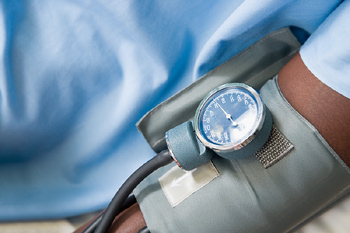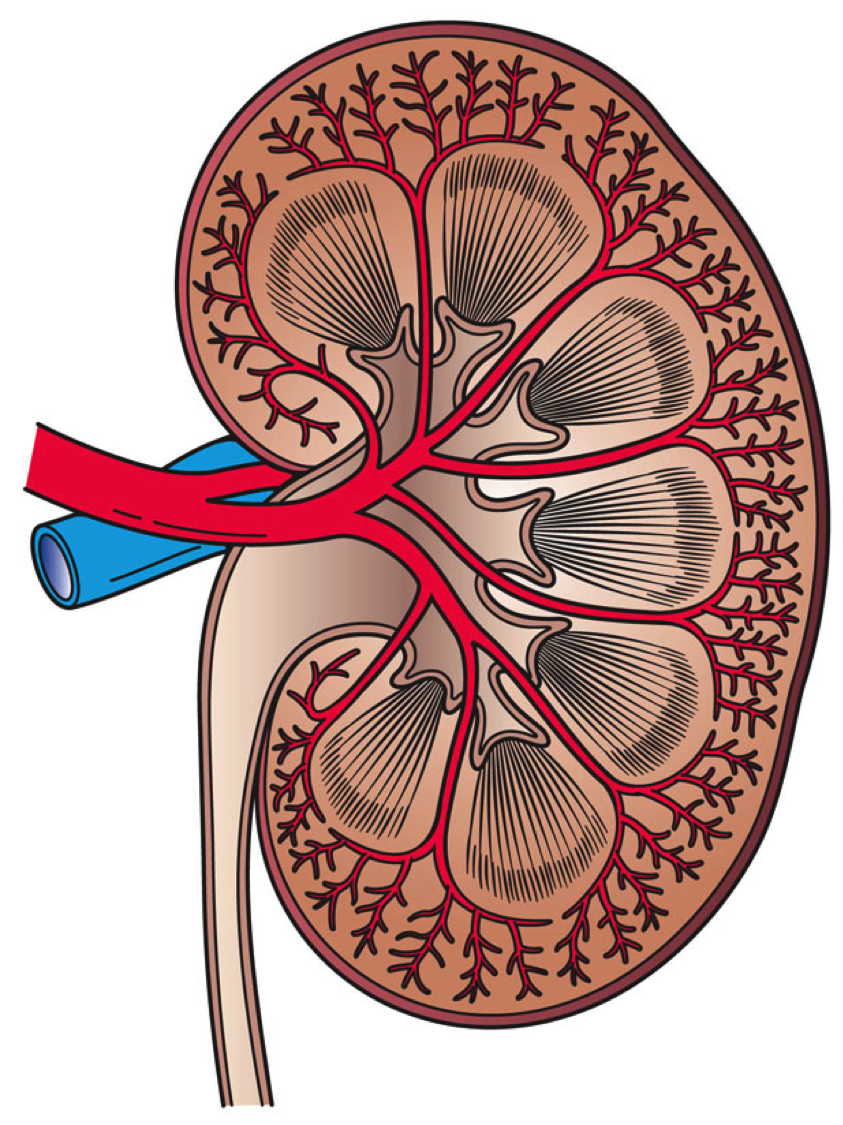Fluid Station1.1 LAB
Fluid Systems in Health Fields
Understanding Blood Pressure
- Lab Goal: The goal of this lab is to accurately measure blood pressure, record results and verbalize ways that hypertension (high blood pressure) can damage the body.
- Lab Materials Required: Hypertension model, blood pressure cuff (sphygmomanometer), stethoscope, pencil, paper, answer sheet 1, and graphing answer sheet. (all provided)
- Objectives for the Experiment:
- List the effects that long term high blood pressure can have on the body, and analyze damaged organs on a model.
- Identify the relationship between hypertension and fluid overload in the body.
- Accurately measure and record blood pressure.
- Explain what is being measured by systolic and diastolic pressures.
- Correctly convert readings to fractions.
- Assess results to determine whether they are in normal range for healthy heart.
- Correctly define terms related to hypertension and fluid balance.
- Name diseases and injuries that can result from long-term high blood pressure
- Applied Math Skills Acquired: (Note: You will practice all of the skills you use in this lab when you complete the math section in this station.)
- Demonstrate a working knowledge of Fractions, Decimals and Percentages.
- Demonstrate how to transfer readings to a graph.
- Prerequisite knowledge: 6th-grade reading level. All instructions are provided.
- Evaluation: Your lab performance will be evaluated by the criteria (standards) you will find in this project’s rubric. A rubric is simply a table that states how you will be evaluated. Your coach will use this table to report your performance.
- Applied Health Terminology: Like many professions, the medical field has its own vocabulary. We have created flashcards to help you learn some of the vocabulary related to joints and movement that was used in this lesson. You can find these flashcards on the computer at the site below.
Instructions to Flaschcard site:
- Click on the link below.
https://quizlet.com/87011983/fluid-station-11-blood-pressure-flash-cards/ - Then click on the “Flashcards” button in the upper left corner of the screen.
- For each card, say the word out loud and try to say what you think the definition is.
- Flip the card by clicking on it and say the definition listed out loud.
- Notice that there are other tabs at the top of the first page, under STUDY. Click on each of those tabs to practice the new terms you are learning.
_______________________________________
INTRODUCTION
Interesting Facts to Know
Do you, or someone you know, have high blood pressure?
Do you know anyone who has been told by their doctor they have clogged arteries?
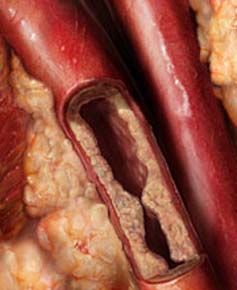
Just like fluid systems in industry, your body has a fluid system: the circulatory (SER-cue-luh-tor-ee) system. In the circulatory system, your heart pumps blood to your organs, tissues, and cells. Blood must be able to reach all cells of the body to supply them with oxygen and nutrients. Blood also removes carbon dioxide (CAR-bun die-OX-ide), a waste gas made by the cells, as well as other waste products. |
Arteries (AR-tur-ees) are blood vessels that carry blood away from the heart. Healthy arteries are flexible and muscular. Their inside lining is smooth so that blood flows freely. Veins (VAYNS) are blood vessels that carry blood toward the heart. They are also flexible, but don’t have a lot of muscle. The body’s skeletal muscles surround veins and help to pump blood back to the heart.
It is normal for blood pressure to change during the day with physical activity or stress. Diet can also affect blood pressure, such as how much salt you eat or how much fluid you drink. Certain diseases can also cause abnormal blood pressure.
If you have chronic (KRON-ick), or long lasting high blood pressure, also called hypertension (HI-per-TEN-shun), the high pressure of blood flowing through your arteries can gradually cause a variety of problems.
High blood pressure can damage the cells on the inside lining of your arteries. This, in turn, causes the walls to thicken and become stiff due to scarring of the vessel walls.
The result is a disease called arteriosclerosis (ahr-teer-ee-o-sklare-O-sis), or hardening of the arteries. This scarring also makes the inside of the arteries rough, which prevents smooth blood flow.
| Fats from your diet enter your bloodstream. They pass through the cells of the blood vessels and can collect on the rough, damaged cells that resulted from high blood pressure. The fats turn into a plaque that is hard and sticks to the inside lining of the arteries. This is called atherosclerosis (ath-ur-o-sklare-O-sis), a special type of arteriosclerosis. The build-up of plaque makes the size of the arteries much smaller, and harder for blood to flow through. Look at the model provided to see a close-up view of an artery suffering from atherosclerosis, and how it can make it easier for a blood clot to get lodged in the vessel. Use the key card on the back of the model to read more about this condition. | 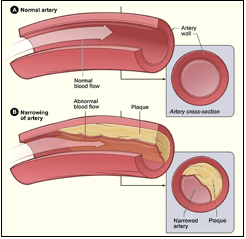 |
This can happen anywhere, blocking blood flow to your kidneys, brain, arms, legs and many other parts of the body. It often affects the arteries of the heart, called coronary arteries. When this happens, a person is said to have coronary artery disease, and this can block blood flow to the heart itself.
Do you know people who have been told that they have had a heart attack?
When blood can't flow freely to your heart, you can experience many problems, including chest pain (also called angina), or a heart attack.
A heart attack, also called a myocardial infarction(my-o-CAR-dee-uhl in-FARK-shun) occurs when part of the heart cannot get any oxygen-rich blood at all and that part begins to die. A common cause of heart attack is when a blood clot or piece of plaque gets stuck in the coronary arteries that have become narrow because of atherosclerosis. Look at the model provided to see a close-up view of the tissue damage done by a heart attack. You can open the heart model and look inside too. Use the key card on the back of the model to read more about this condition.
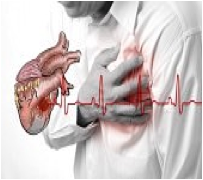
High blood pressure also makes the heart work much harder to push blood through the vessels. Eventually the heart may start to fail because it has been forced to work too hard over a long period of time. This can lead to a disease known as CHF (congestive heart failure), in which blood is not being moved fast enough and fluid starts backing up into the lungs or body.
A stroke (CVA or cerebrovascular accident) can occur when a piece of plaque breaks off of the vessel wall and travels up to the brain. The plaque then gets stuck in an artery and blocks blood flow to part of the brain, which can cause permanent damage. Look at the model provided to see a close-up view of the tissue damage done by a stroke. Use the key card on the back of the model to read more about this condition.
Having blocked arteries due to atherosclerosis anywhere in the body outside of the heart or brain is called peripheral vascular disease. Small clots in these areas can break free and cause an embolism (lodging of a blood clot) in other parts of the body.
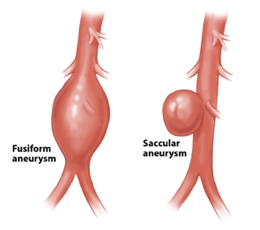 |
High blood pressure can also cause an aneurysm (AN-yur-ism), a sort of “balloon” caused by weakening of the vessel wall. Over time an aneurysm may burst, causing the person to bleed out into the body. This is a life-threatening condition. |
| Arteriosclerosis, or hardening of the arteries, can even occur in the small arteries of the kidneys. This can cause hardening of the entire kidney, and eventually may lead to complete kidney failure. Kidney failure is life-threatening because normally the kidneys filter waste from the blood and excrete it as urine. Loss of this filtering ability can cause a toxic build-up of these wastes. When people suffer from kidney failure, they must go through something called dialysis, which is when they are hooked up to machine that pulls their blood out and filters it for them before returning it back to the body. Look at the model provided to see a close-up view of the tissue damage done to the kidneys due to hypertension. Use the key card on the back of the model to read more about this condition. |
|
Hypertension can even do damage to the eyes! Many severe changes can occur in the retina (the membrane in the back of the eye that actually senses light coming into your eye) due to chronic high blood pressure. Extensive retinal damage may eventually lead to blindness. Look at the model provided to see a close-up view of the tissue damage done to the eyes due to hypertension. Use the key card on the back of the model to read more about this condition.
In this lab, you will learn more about measuring blood pressure, which as you can see, is important to monitor to ensure a healthy body.
Test Your Knowledge
On your computer, open the following link and take pre-test.
Discuss your results with your coach and other students. What do you want to know more about? What did you find out?
Process Summary: In this Lab you will:
- Review the medical vocabulary and read instructions on how to take someone’s blood pressure
- Practice taking the blood pressure of different people.
- Translate the reading on the blood pressure gauge to fractions for recording and creating a graph.
- Define hypertension. You will identify the signs and symptoms of hypertension and observe how it effects the fluid balance in the heart and other parts of the body.
- Answer questions related to the data you gathered, as well as how blood pressure is related to overall health
__________________________________________
Links to Station 1.1 Modules
